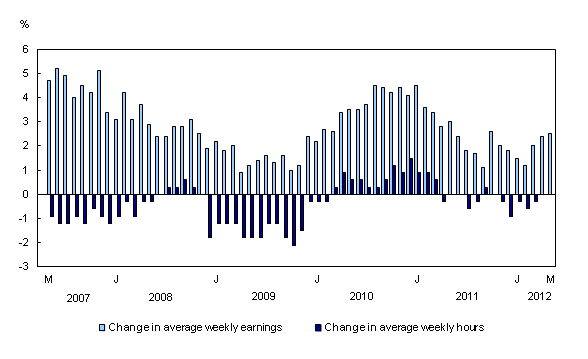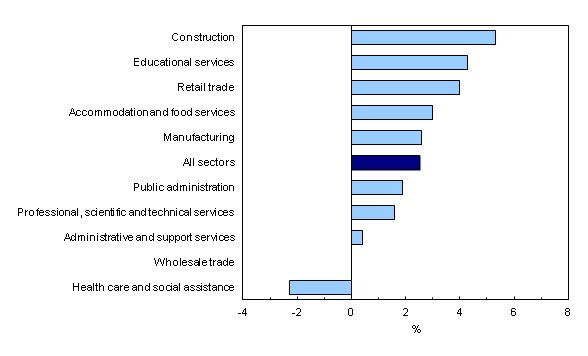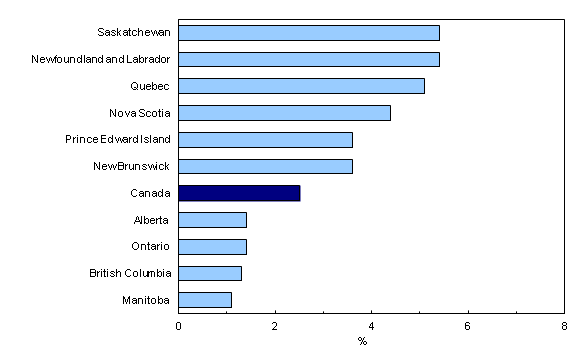Payroll employment, earnings and hours, May 2012
Archived Content
Information identified as archived is provided for reference, research or recordkeeping purposes. It is not subject to the Government of Canada Web Standards and has not been altered or updated since it was archived. Please "contact us" to request a format other than those available.
Related subjects
-
[an error occurred while processing this directive]
In May, average weekly earnings of non-farm payroll employees were $894.61, up 0.5% from the previous month. On a year-over-year basis, earnings increased 2.5%.
Year-over-year change in average weekly hours and average weekly earnings

Chart description: Year-over-year change in average weekly hours and average weekly earnings
The 2.5% increase during the 12 months to May reflects a number of factors, including wage growth and changes in the composition of employment by industry, occupation and level of job experience.
Average hours worked per week can also contribute to increases in earnings. In May, however, non-farm payroll employees worked an average of 32.9 hours per week, unchanged both from the month before and from 12 months earlier.
Average weekly earnings by sector
Year-over-year growth in average weekly earnings outpaced the national average of 2.5% in five of the largest industrial sectors: construction; educational services; retail trade; accommodation and food services; and manufacturing. In contrast, earnings declined in health care and social assistance.
Year-over-year change in average weekly earnings in the 10 largest sectors, May 2011 to May 2012

In construction, weekly earnings increased 5.3% to $1,133.09, and growth was widespread across all industries in this sector.
Average weekly earnings in educational services increased 4.3% to $990.65 in the 12 months to May. The most notable growth was within elementary and secondary schools.
In retail trade, one of the lowest-paid sectors on average, weekly earnings rose 4.0% to $536.89. There were notable gains among retail stores for clothing and clothing accessories; general merchandise; and health and personal care stores.
Weekly earnings in accommodation and food services increased 3.0% to $366.63 in the 12 months to May. Growth was most notable in special food services and limited-service eating places.
In manufacturing, weekly earnings increased 2.6% to $1,008.76, with the most notable growth among manufacturers of wood products, transportation equipment and food.
Weekly earnings of payroll employees in health care and social assistance fell 2.3% to $793.48. Earnings declined in general medical and surgical hospitals; home health care services; individual and family services; and nursing care facilities.
Average weekly earnings up in every province
Average weekly earnings of non-farm payroll employees increased in every province in the 12 months to May. Growth was highest in Saskatchewan and Newfoundland and Labrador.
Year-over-year growth in average weekly earnings by province, May 2011 to May 2012

In Saskatchewan, average weekly earnings were $897.80 in May, up 5.4% from 12 months earlier. Earnings in the province have been higher than the national average since August 2011.
In Newfoundland and Labrador, average weekly earnings increased 5.4% to $918.59, the second-highest level among the provinces after Alberta. Year-over-year growth in Newfoundland and Labrador has exceeded the national average since December 2010.
In the 12 months to May, average weekly earnings in Quebec rose 5.1% to $835.60, and in Nova Scotia, they grew 4.4% to $793.73.
The lowest year-over-year growth occurred in Manitoba, where earnings increased 1.1% to $820.71.
Non-farm payroll employment by sector
Total non-farm payroll employment rose by 76,900 between April and May, the third consecutive monthly increase. Most sectors showed job gains in May.
On a year-over-year basis, non-farm payroll employment increased 2.3% (+338,000). Over half of the gains have occurred since February 2012.
Among all sectors, mining, quarrying and oil and gas extraction posted the highest 12-month employment growth rate, at 6.8%. It was followed by construction at 6.3% and accommodation and food services at 4.0%.
Note to readers
The Survey of Employment, Payrolls and Hours (SEPH) is a business census of non-farm payroll employees. Its key objective is to provide a monthly portrait of the level of earnings, the number of jobs and hours worked by detailed industry at the national, provincial and territorial level.
Statistics Canada also produces employment estimates from its monthly Labour Force Survey (LFS). The LFS is a household survey, the main objective of which is to divide the working-age population into three mutually exclusive groups: the employed (including the self-employed), unemployed and not in the labour force. This survey is the official source for the unemployment rate and collects data on the socio-demographic characteristics of all those in the labour market.
As a result of conceptual and methodological differences, estimates of changes from SEPH and LFS do differ from time to time. However, the trends in the data are quite similar.
Unless otherwise stated, this release presents seasonally adjusted data, which facilitates comparisons by removing the effects of seasonal variations. For more information on seasonal adjustment, see Seasonal adjustment and identifying economic trends.
Non-farm payroll employment data are for all hourly and salaried employees, as well as the "other employees" category, which includes piece-rate and commission-only employees.
Average weekly hours data are for hourly and salaried employees only and exclude businesses that could not be classified to a North American Industry Classification System (NAICS) code.
All earnings data include overtime pay and exclude businesses that could not be classified to a NAICS code. Earnings data are based on gross taxable payroll before source deductions.
Average weekly earnings are derived by dividing total weekly earnings by the number of employees.
Available without charge in CANSIM: tables CANSIM table281-0023 to 281-0039 and CANSIM table281-0041 to 281-0049.
Definitions, data sources and methods: survey number survey number2612.
A data table is available from the Key resource module of our website under Summary tables.
Detailed industry data, data by size of enterprise based on employment, and other labour market indicators will soon be available in the monthly publication Employment, Earnings and Hours, Vol. 90, no. 5 (Catalogue number72-002-X, free).
Data on payroll employment, earnings and hours for June will be released on August 30.
For more information, contact Statistics Canada's National Contact Centre (toll-free 1-800-263-1136; 613-951-8116; infostats@statcan.gc.ca).
To enquire about the concepts, methods or data quality of this release, contact Jason Gilmore (613-951-7118; jason.gilmore@statcan.gc.ca), Labour Statistics Division.
- Date modified:
